Critical Evaluation of Anglo Irish Bank's Insolvency Due to Financial Crisis
VerifiedAdded on 2023/06/03
|8
|2504
|443
AI Summary
This essay presents a critical evaluation of a public listed company, Anglo Irish Bank, that has suffered insolvency due to financial crisis. It discusses the bank's history, initial success drivers, major changes in its structure, reasons for its failure, social impact of the failure, and lessons learned.
Contribute Materials
Your contribution can guide someone’s learning journey. Share your
documents today.
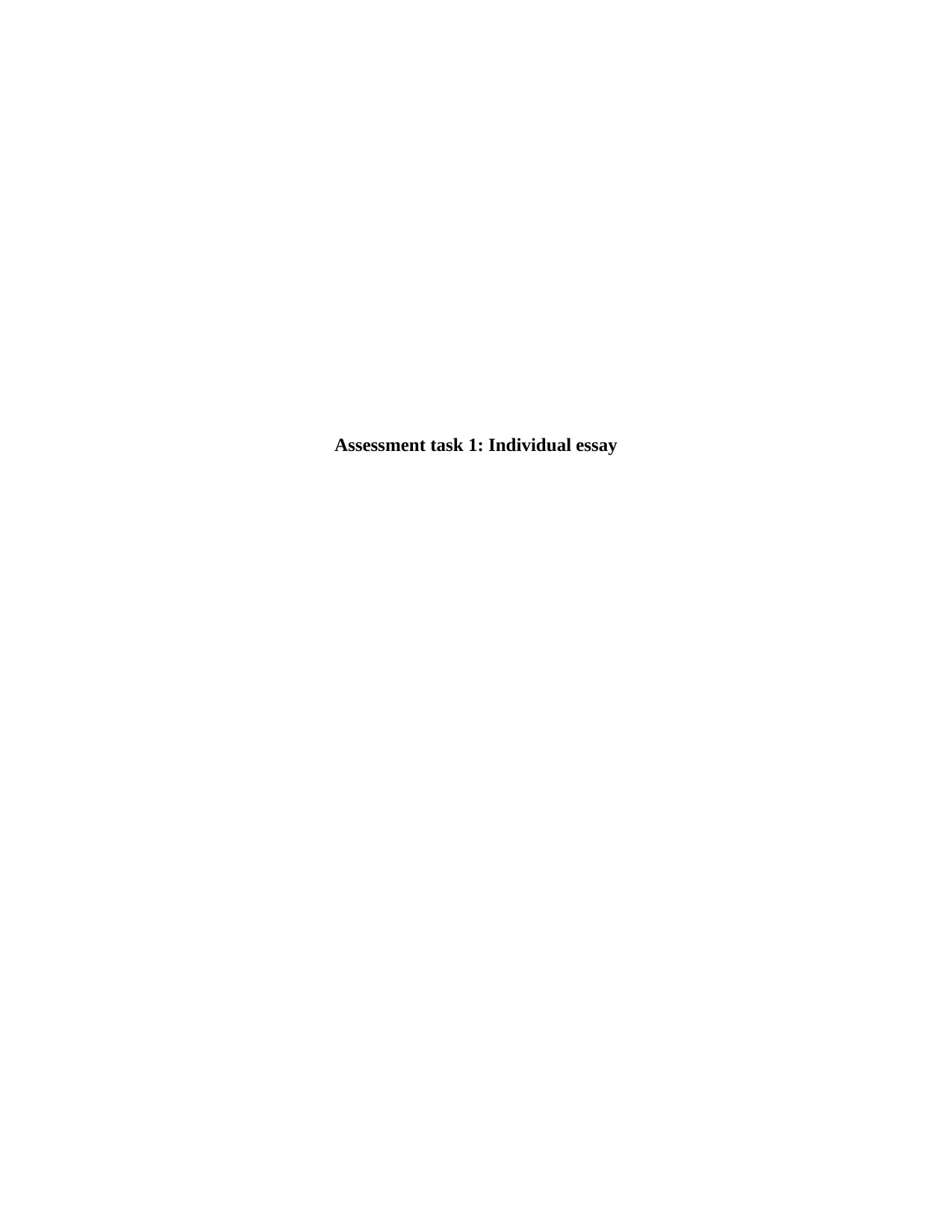
Assessment task 1: Individual essay
Secure Best Marks with AI Grader
Need help grading? Try our AI Grader for instant feedback on your assignments.
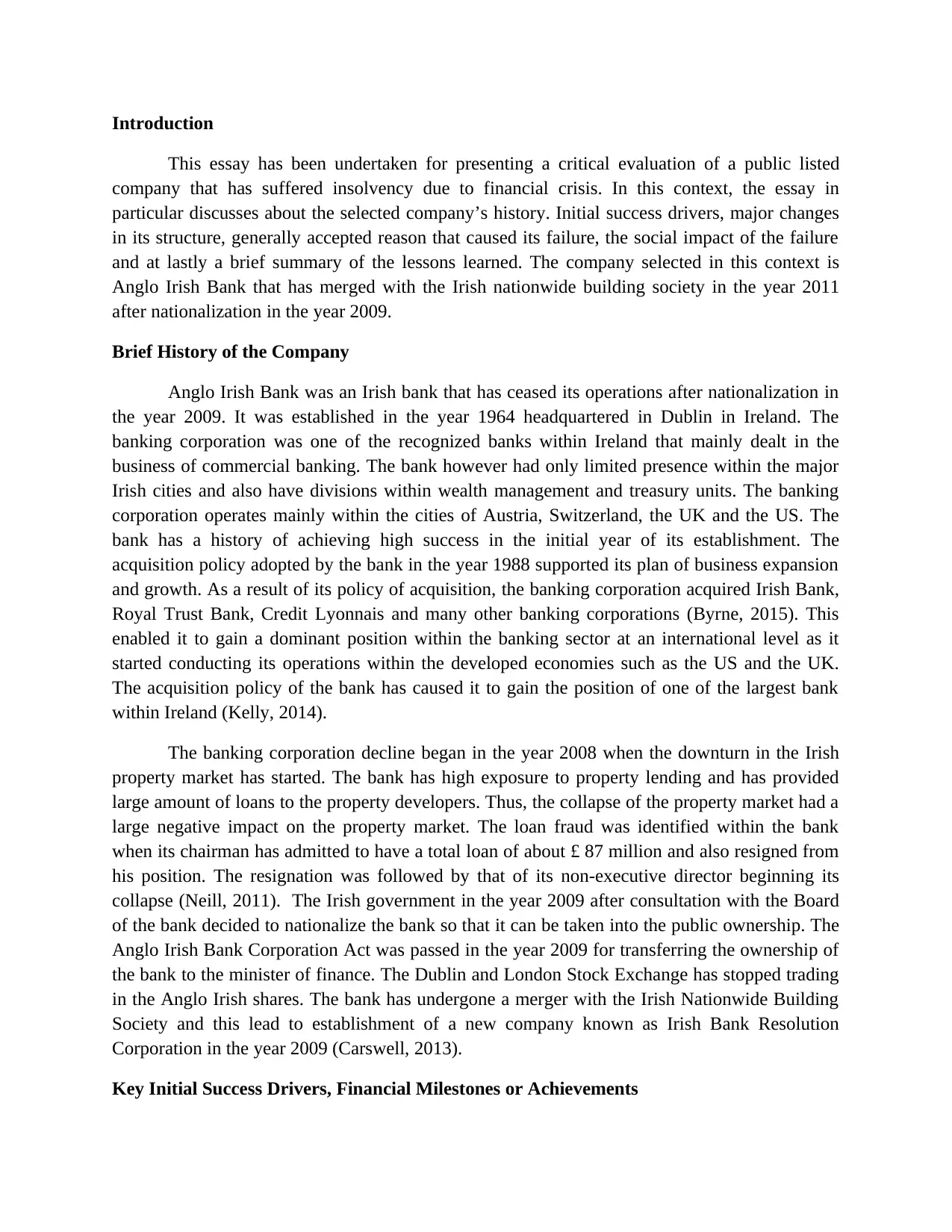
Introduction
This essay has been undertaken for presenting a critical evaluation of a public listed
company that has suffered insolvency due to financial crisis. In this context, the essay in
particular discusses about the selected company’s history. Initial success drivers, major changes
in its structure, generally accepted reason that caused its failure, the social impact of the failure
and at lastly a brief summary of the lessons learned. The company selected in this context is
Anglo Irish Bank that has merged with the Irish nationwide building society in the year 2011
after nationalization in the year 2009.
Brief History of the Company
Anglo Irish Bank was an Irish bank that has ceased its operations after nationalization in
the year 2009. It was established in the year 1964 headquartered in Dublin in Ireland. The
banking corporation was one of the recognized banks within Ireland that mainly dealt in the
business of commercial banking. The bank however had only limited presence within the major
Irish cities and also have divisions within wealth management and treasury units. The banking
corporation operates mainly within the cities of Austria, Switzerland, the UK and the US. The
bank has a history of achieving high success in the initial year of its establishment. The
acquisition policy adopted by the bank in the year 1988 supported its plan of business expansion
and growth. As a result of its policy of acquisition, the banking corporation acquired Irish Bank,
Royal Trust Bank, Credit Lyonnais and many other banking corporations (Byrne, 2015). This
enabled it to gain a dominant position within the banking sector at an international level as it
started conducting its operations within the developed economies such as the US and the UK.
The acquisition policy of the bank has caused it to gain the position of one of the largest bank
within Ireland (Kelly, 2014).
The banking corporation decline began in the year 2008 when the downturn in the Irish
property market has started. The bank has high exposure to property lending and has provided
large amount of loans to the property developers. Thus, the collapse of the property market had a
large negative impact on the property market. The loan fraud was identified within the bank
when its chairman has admitted to have a total loan of about £ 87 million and also resigned from
his position. The resignation was followed by that of its non-executive director beginning its
collapse (Neill, 2011). The Irish government in the year 2009 after consultation with the Board
of the bank decided to nationalize the bank so that it can be taken into the public ownership. The
Anglo Irish Bank Corporation Act was passed in the year 2009 for transferring the ownership of
the bank to the minister of finance. The Dublin and London Stock Exchange has stopped trading
in the Anglo Irish shares. The bank has undergone a merger with the Irish Nationwide Building
Society and this lead to establishment of a new company known as Irish Bank Resolution
Corporation in the year 2009 (Carswell, 2013).
Key Initial Success Drivers, Financial Milestones or Achievements
This essay has been undertaken for presenting a critical evaluation of a public listed
company that has suffered insolvency due to financial crisis. In this context, the essay in
particular discusses about the selected company’s history. Initial success drivers, major changes
in its structure, generally accepted reason that caused its failure, the social impact of the failure
and at lastly a brief summary of the lessons learned. The company selected in this context is
Anglo Irish Bank that has merged with the Irish nationwide building society in the year 2011
after nationalization in the year 2009.
Brief History of the Company
Anglo Irish Bank was an Irish bank that has ceased its operations after nationalization in
the year 2009. It was established in the year 1964 headquartered in Dublin in Ireland. The
banking corporation was one of the recognized banks within Ireland that mainly dealt in the
business of commercial banking. The bank however had only limited presence within the major
Irish cities and also have divisions within wealth management and treasury units. The banking
corporation operates mainly within the cities of Austria, Switzerland, the UK and the US. The
bank has a history of achieving high success in the initial year of its establishment. The
acquisition policy adopted by the bank in the year 1988 supported its plan of business expansion
and growth. As a result of its policy of acquisition, the banking corporation acquired Irish Bank,
Royal Trust Bank, Credit Lyonnais and many other banking corporations (Byrne, 2015). This
enabled it to gain a dominant position within the banking sector at an international level as it
started conducting its operations within the developed economies such as the US and the UK.
The acquisition policy of the bank has caused it to gain the position of one of the largest bank
within Ireland (Kelly, 2014).
The banking corporation decline began in the year 2008 when the downturn in the Irish
property market has started. The bank has high exposure to property lending and has provided
large amount of loans to the property developers. Thus, the collapse of the property market had a
large negative impact on the property market. The loan fraud was identified within the bank
when its chairman has admitted to have a total loan of about £ 87 million and also resigned from
his position. The resignation was followed by that of its non-executive director beginning its
collapse (Neill, 2011). The Irish government in the year 2009 after consultation with the Board
of the bank decided to nationalize the bank so that it can be taken into the public ownership. The
Anglo Irish Bank Corporation Act was passed in the year 2009 for transferring the ownership of
the bank to the minister of finance. The Dublin and London Stock Exchange has stopped trading
in the Anglo Irish shares. The bank has undergone a merger with the Irish Nationwide Building
Society and this lead to establishment of a new company known as Irish Bank Resolution
Corporation in the year 2009 (Carswell, 2013).
Key Initial Success Drivers, Financial Milestones or Achievements
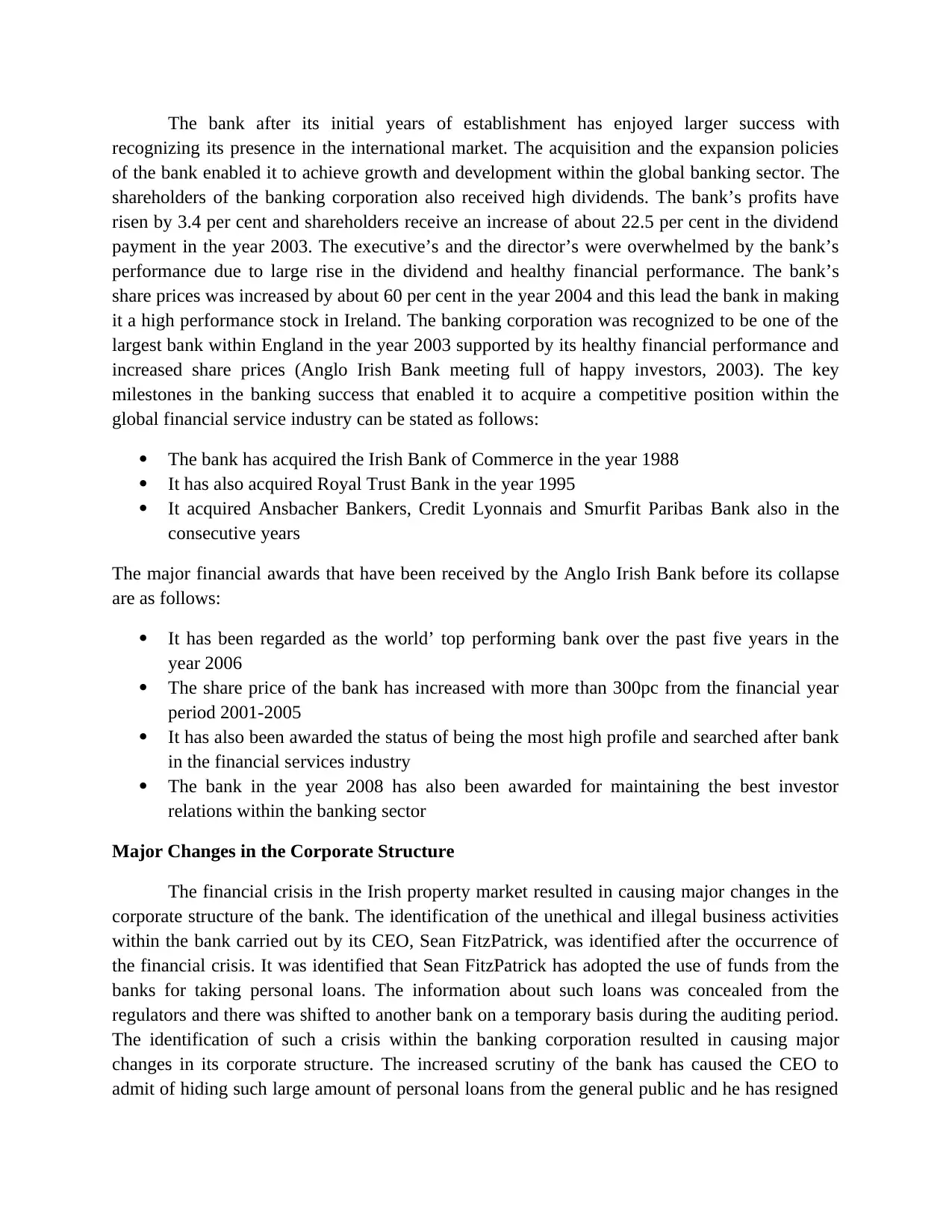
The bank after its initial years of establishment has enjoyed larger success with
recognizing its presence in the international market. The acquisition and the expansion policies
of the bank enabled it to achieve growth and development within the global banking sector. The
shareholders of the banking corporation also received high dividends. The bank’s profits have
risen by 3.4 per cent and shareholders receive an increase of about 22.5 per cent in the dividend
payment in the year 2003. The executive’s and the director’s were overwhelmed by the bank’s
performance due to large rise in the dividend and healthy financial performance. The bank’s
share prices was increased by about 60 per cent in the year 2004 and this lead the bank in making
it a high performance stock in Ireland. The banking corporation was recognized to be one of the
largest bank within England in the year 2003 supported by its healthy financial performance and
increased share prices (Anglo Irish Bank meeting full of happy investors, 2003). The key
milestones in the banking success that enabled it to acquire a competitive position within the
global financial service industry can be stated as follows:
The bank has acquired the Irish Bank of Commerce in the year 1988
It has also acquired Royal Trust Bank in the year 1995
It acquired Ansbacher Bankers, Credit Lyonnais and Smurfit Paribas Bank also in the
consecutive years
The major financial awards that have been received by the Anglo Irish Bank before its collapse
are as follows:
It has been regarded as the world’ top performing bank over the past five years in the
year 2006
The share price of the bank has increased with more than 300pc from the financial year
period 2001-2005
It has also been awarded the status of being the most high profile and searched after bank
in the financial services industry
The bank in the year 2008 has also been awarded for maintaining the best investor
relations within the banking sector
Major Changes in the Corporate Structure
The financial crisis in the Irish property market resulted in causing major changes in the
corporate structure of the bank. The identification of the unethical and illegal business activities
within the bank carried out by its CEO, Sean FitzPatrick, was identified after the occurrence of
the financial crisis. It was identified that Sean FitzPatrick has adopted the use of funds from the
banks for taking personal loans. The information about such loans was concealed from the
regulators and there was shifted to another bank on a temporary basis during the auditing period.
The identification of such a crisis within the banking corporation resulted in causing major
changes in its corporate structure. The increased scrutiny of the bank has caused the CEO to
admit of hiding such large amount of personal loans from the general public and he has resigned
recognizing its presence in the international market. The acquisition and the expansion policies
of the bank enabled it to achieve growth and development within the global banking sector. The
shareholders of the banking corporation also received high dividends. The bank’s profits have
risen by 3.4 per cent and shareholders receive an increase of about 22.5 per cent in the dividend
payment in the year 2003. The executive’s and the director’s were overwhelmed by the bank’s
performance due to large rise in the dividend and healthy financial performance. The bank’s
share prices was increased by about 60 per cent in the year 2004 and this lead the bank in making
it a high performance stock in Ireland. The banking corporation was recognized to be one of the
largest bank within England in the year 2003 supported by its healthy financial performance and
increased share prices (Anglo Irish Bank meeting full of happy investors, 2003). The key
milestones in the banking success that enabled it to acquire a competitive position within the
global financial service industry can be stated as follows:
The bank has acquired the Irish Bank of Commerce in the year 1988
It has also acquired Royal Trust Bank in the year 1995
It acquired Ansbacher Bankers, Credit Lyonnais and Smurfit Paribas Bank also in the
consecutive years
The major financial awards that have been received by the Anglo Irish Bank before its collapse
are as follows:
It has been regarded as the world’ top performing bank over the past five years in the
year 2006
The share price of the bank has increased with more than 300pc from the financial year
period 2001-2005
It has also been awarded the status of being the most high profile and searched after bank
in the financial services industry
The bank in the year 2008 has also been awarded for maintaining the best investor
relations within the banking sector
Major Changes in the Corporate Structure
The financial crisis in the Irish property market resulted in causing major changes in the
corporate structure of the bank. The identification of the unethical and illegal business activities
within the bank carried out by its CEO, Sean FitzPatrick, was identified after the occurrence of
the financial crisis. It was identified that Sean FitzPatrick has adopted the use of funds from the
banks for taking personal loans. The information about such loans was concealed from the
regulators and there was shifted to another bank on a temporary basis during the auditing period.
The identification of such a crisis within the banking corporation resulted in causing major
changes in its corporate structure. The increased scrutiny of the bank has caused the CEO to
admit of hiding such large amount of personal loans from the general public and he has resigned
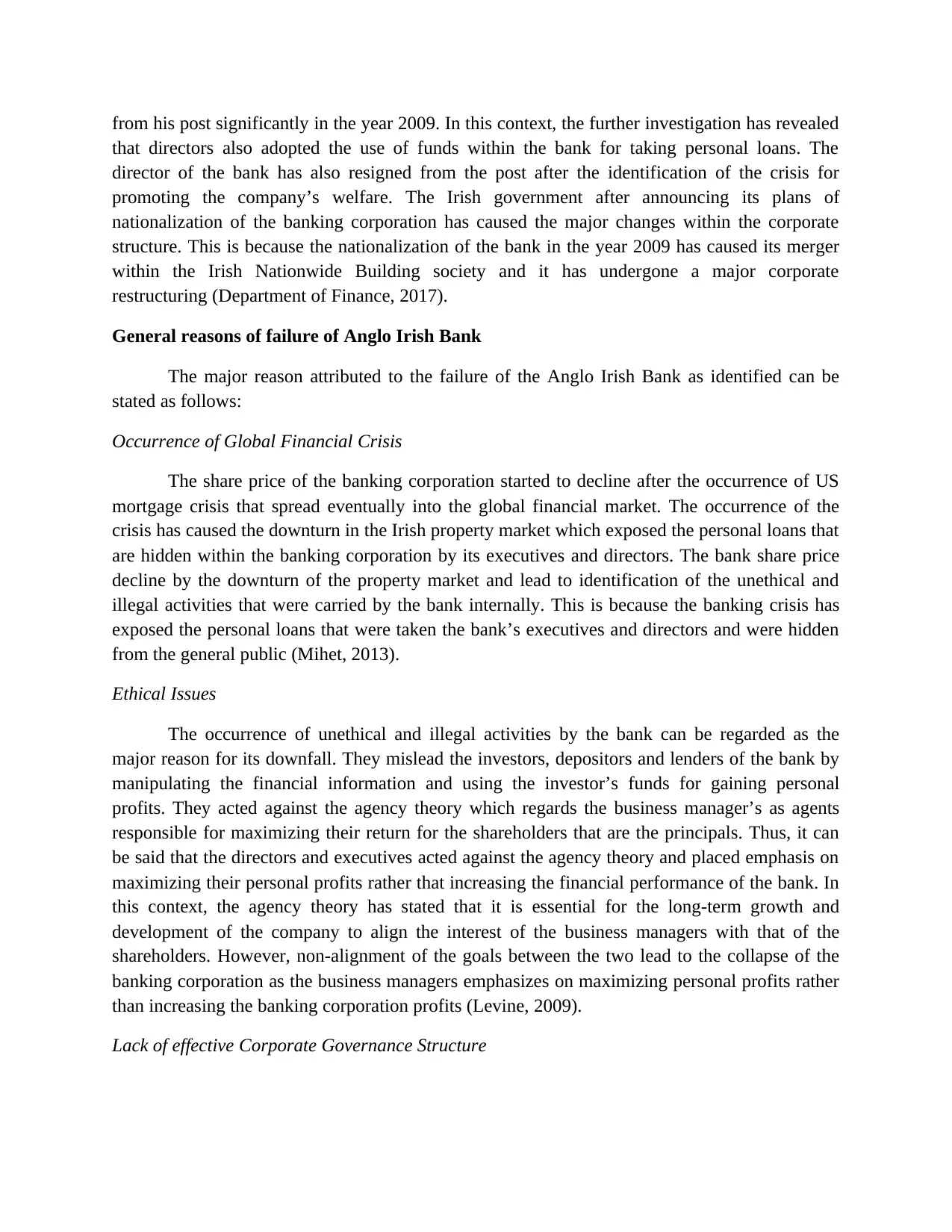
from his post significantly in the year 2009. In this context, the further investigation has revealed
that directors also adopted the use of funds within the bank for taking personal loans. The
director of the bank has also resigned from the post after the identification of the crisis for
promoting the company’s welfare. The Irish government after announcing its plans of
nationalization of the banking corporation has caused the major changes within the corporate
structure. This is because the nationalization of the bank in the year 2009 has caused its merger
within the Irish Nationwide Building society and it has undergone a major corporate
restructuring (Department of Finance, 2017).
General reasons of failure of Anglo Irish Bank
The major reason attributed to the failure of the Anglo Irish Bank as identified can be
stated as follows:
Occurrence of Global Financial Crisis
The share price of the banking corporation started to decline after the occurrence of US
mortgage crisis that spread eventually into the global financial market. The occurrence of the
crisis has caused the downturn in the Irish property market which exposed the personal loans that
are hidden within the banking corporation by its executives and directors. The bank share price
decline by the downturn of the property market and lead to identification of the unethical and
illegal activities that were carried by the bank internally. This is because the banking crisis has
exposed the personal loans that were taken the bank’s executives and directors and were hidden
from the general public (Mihet, 2013).
Ethical Issues
The occurrence of unethical and illegal activities by the bank can be regarded as the
major reason for its downfall. They mislead the investors, depositors and lenders of the bank by
manipulating the financial information and using the investor’s funds for gaining personal
profits. They acted against the agency theory which regards the business manager’s as agents
responsible for maximizing their return for the shareholders that are the principals. Thus, it can
be said that the directors and executives acted against the agency theory and placed emphasis on
maximizing their personal profits rather that increasing the financial performance of the bank. In
this context, the agency theory has stated that it is essential for the long-term growth and
development of the company to align the interest of the business managers with that of the
shareholders. However, non-alignment of the goals between the two lead to the collapse of the
banking corporation as the business managers emphasizes on maximizing personal profits rather
than increasing the banking corporation profits (Levine, 2009).
Lack of effective Corporate Governance Structure
that directors also adopted the use of funds within the bank for taking personal loans. The
director of the bank has also resigned from the post after the identification of the crisis for
promoting the company’s welfare. The Irish government after announcing its plans of
nationalization of the banking corporation has caused the major changes within the corporate
structure. This is because the nationalization of the bank in the year 2009 has caused its merger
within the Irish Nationwide Building society and it has undergone a major corporate
restructuring (Department of Finance, 2017).
General reasons of failure of Anglo Irish Bank
The major reason attributed to the failure of the Anglo Irish Bank as identified can be
stated as follows:
Occurrence of Global Financial Crisis
The share price of the banking corporation started to decline after the occurrence of US
mortgage crisis that spread eventually into the global financial market. The occurrence of the
crisis has caused the downturn in the Irish property market which exposed the personal loans that
are hidden within the banking corporation by its executives and directors. The bank share price
decline by the downturn of the property market and lead to identification of the unethical and
illegal activities that were carried by the bank internally. This is because the banking crisis has
exposed the personal loans that were taken the bank’s executives and directors and were hidden
from the general public (Mihet, 2013).
Ethical Issues
The occurrence of unethical and illegal activities by the bank can be regarded as the
major reason for its downfall. They mislead the investors, depositors and lenders of the bank by
manipulating the financial information and using the investor’s funds for gaining personal
profits. They acted against the agency theory which regards the business manager’s as agents
responsible for maximizing their return for the shareholders that are the principals. Thus, it can
be said that the directors and executives acted against the agency theory and placed emphasis on
maximizing their personal profits rather that increasing the financial performance of the bank. In
this context, the agency theory has stated that it is essential for the long-term growth and
development of the company to align the interest of the business managers with that of the
shareholders. However, non-alignment of the goals between the two lead to the collapse of the
banking corporation as the business managers emphasizes on maximizing personal profits rather
than increasing the banking corporation profits (Levine, 2009).
Lack of effective Corporate Governance Structure
Secure Best Marks with AI Grader
Need help grading? Try our AI Grader for instant feedback on your assignments.
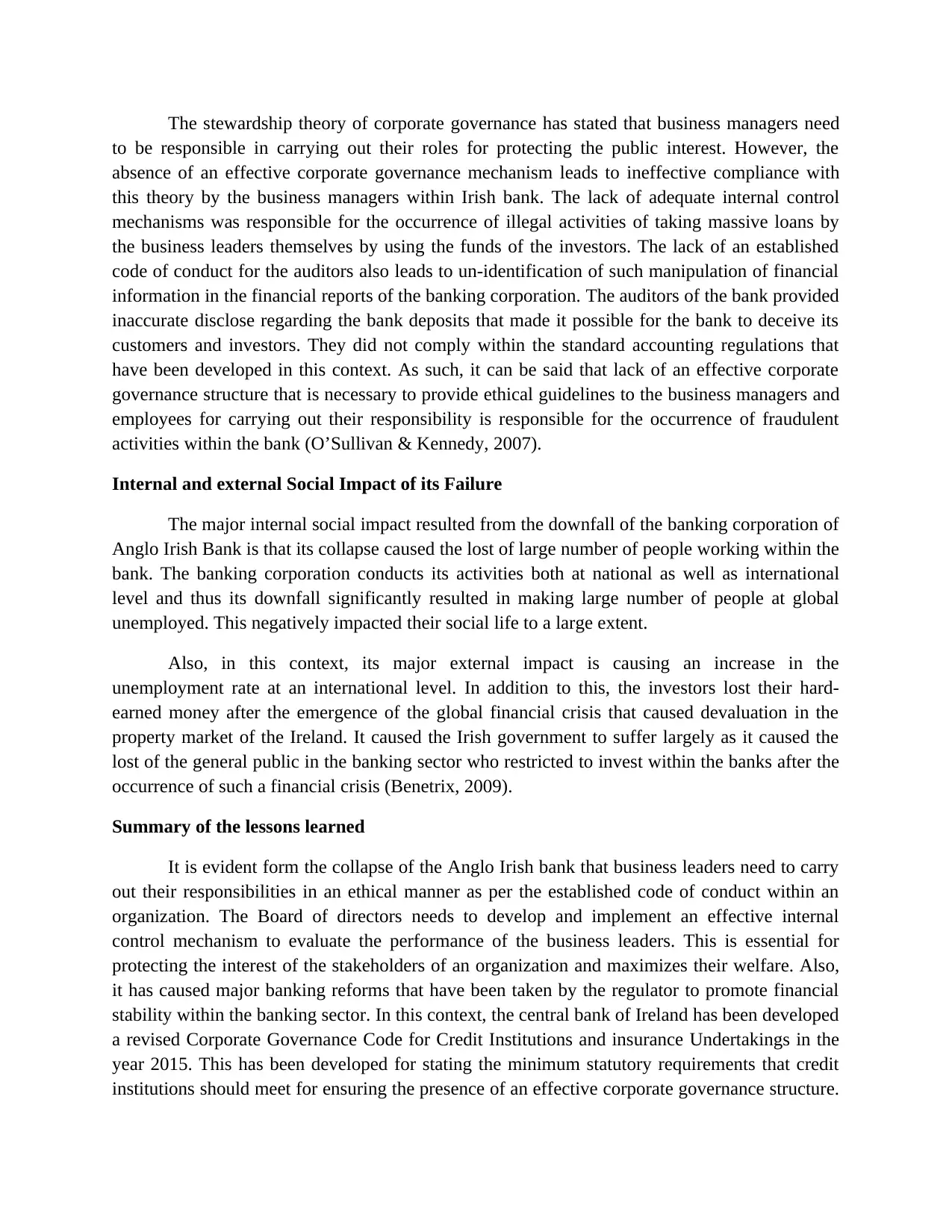
The stewardship theory of corporate governance has stated that business managers need
to be responsible in carrying out their roles for protecting the public interest. However, the
absence of an effective corporate governance mechanism leads to ineffective compliance with
this theory by the business managers within Irish bank. The lack of adequate internal control
mechanisms was responsible for the occurrence of illegal activities of taking massive loans by
the business leaders themselves by using the funds of the investors. The lack of an established
code of conduct for the auditors also leads to un-identification of such manipulation of financial
information in the financial reports of the banking corporation. The auditors of the bank provided
inaccurate disclose regarding the bank deposits that made it possible for the bank to deceive its
customers and investors. They did not comply within the standard accounting regulations that
have been developed in this context. As such, it can be said that lack of an effective corporate
governance structure that is necessary to provide ethical guidelines to the business managers and
employees for carrying out their responsibility is responsible for the occurrence of fraudulent
activities within the bank (O’Sullivan & Kennedy, 2007).
Internal and external Social Impact of its Failure
The major internal social impact resulted from the downfall of the banking corporation of
Anglo Irish Bank is that its collapse caused the lost of large number of people working within the
bank. The banking corporation conducts its activities both at national as well as international
level and thus its downfall significantly resulted in making large number of people at global
unemployed. This negatively impacted their social life to a large extent.
Also, in this context, its major external impact is causing an increase in the
unemployment rate at an international level. In addition to this, the investors lost their hard-
earned money after the emergence of the global financial crisis that caused devaluation in the
property market of the Ireland. It caused the Irish government to suffer largely as it caused the
lost of the general public in the banking sector who restricted to invest within the banks after the
occurrence of such a financial crisis (Benetrix, 2009).
Summary of the lessons learned
It is evident form the collapse of the Anglo Irish bank that business leaders need to carry
out their responsibilities in an ethical manner as per the established code of conduct within an
organization. The Board of directors needs to develop and implement an effective internal
control mechanism to evaluate the performance of the business leaders. This is essential for
protecting the interest of the stakeholders of an organization and maximizes their welfare. Also,
it has caused major banking reforms that have been taken by the regulator to promote financial
stability within the banking sector. In this context, the central bank of Ireland has been developed
a revised Corporate Governance Code for Credit Institutions and insurance Undertakings in the
year 2015. This has been developed for stating the minimum statutory requirements that credit
institutions should meet for ensuring the presence of an effective corporate governance structure.
to be responsible in carrying out their roles for protecting the public interest. However, the
absence of an effective corporate governance mechanism leads to ineffective compliance with
this theory by the business managers within Irish bank. The lack of adequate internal control
mechanisms was responsible for the occurrence of illegal activities of taking massive loans by
the business leaders themselves by using the funds of the investors. The lack of an established
code of conduct for the auditors also leads to un-identification of such manipulation of financial
information in the financial reports of the banking corporation. The auditors of the bank provided
inaccurate disclose regarding the bank deposits that made it possible for the bank to deceive its
customers and investors. They did not comply within the standard accounting regulations that
have been developed in this context. As such, it can be said that lack of an effective corporate
governance structure that is necessary to provide ethical guidelines to the business managers and
employees for carrying out their responsibility is responsible for the occurrence of fraudulent
activities within the bank (O’Sullivan & Kennedy, 2007).
Internal and external Social Impact of its Failure
The major internal social impact resulted from the downfall of the banking corporation of
Anglo Irish Bank is that its collapse caused the lost of large number of people working within the
bank. The banking corporation conducts its activities both at national as well as international
level and thus its downfall significantly resulted in making large number of people at global
unemployed. This negatively impacted their social life to a large extent.
Also, in this context, its major external impact is causing an increase in the
unemployment rate at an international level. In addition to this, the investors lost their hard-
earned money after the emergence of the global financial crisis that caused devaluation in the
property market of the Ireland. It caused the Irish government to suffer largely as it caused the
lost of the general public in the banking sector who restricted to invest within the banks after the
occurrence of such a financial crisis (Benetrix, 2009).
Summary of the lessons learned
It is evident form the collapse of the Anglo Irish bank that business leaders need to carry
out their responsibilities in an ethical manner as per the established code of conduct within an
organization. The Board of directors needs to develop and implement an effective internal
control mechanism to evaluate the performance of the business leaders. This is essential for
protecting the interest of the stakeholders of an organization and maximizes their welfare. Also,
it has caused major banking reforms that have been taken by the regulator to promote financial
stability within the banking sector. In this context, the central bank of Ireland has been developed
a revised Corporate Governance Code for Credit Institutions and insurance Undertakings in the
year 2015. This has been developed for stating the minimum statutory requirements that credit
institutions should meet for ensuring the presence of an effective corporate governance structure.
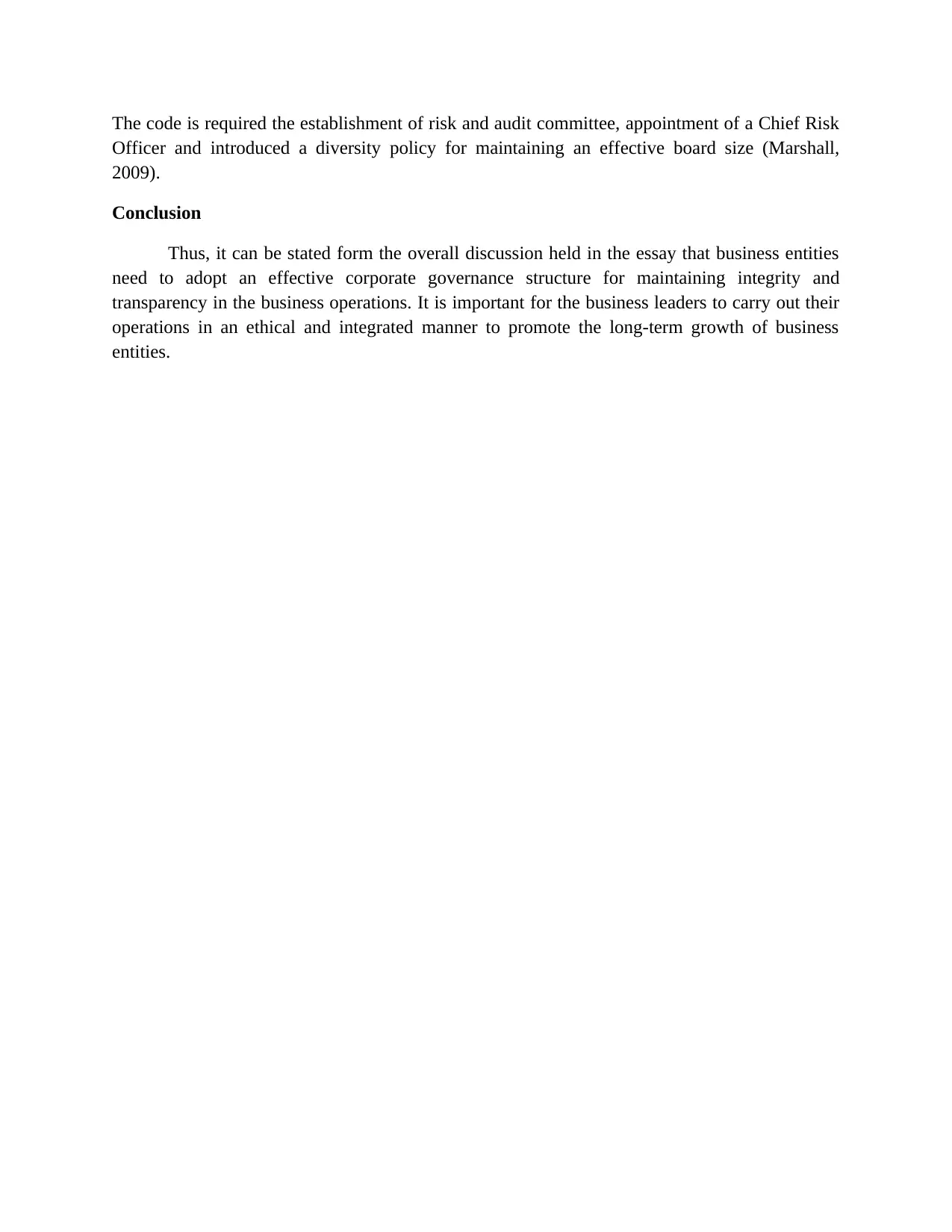
The code is required the establishment of risk and audit committee, appointment of a Chief Risk
Officer and introduced a diversity policy for maintaining an effective board size (Marshall,
2009).
Conclusion
Thus, it can be stated form the overall discussion held in the essay that business entities
need to adopt an effective corporate governance structure for maintaining integrity and
transparency in the business operations. It is important for the business leaders to carry out their
operations in an ethical and integrated manner to promote the long-term growth of business
entities.
Officer and introduced a diversity policy for maintaining an effective board size (Marshall,
2009).
Conclusion
Thus, it can be stated form the overall discussion held in the essay that business entities
need to adopt an effective corporate governance structure for maintaining integrity and
transparency in the business operations. It is important for the business leaders to carry out their
operations in an ethical and integrated manner to promote the long-term growth of business
entities.
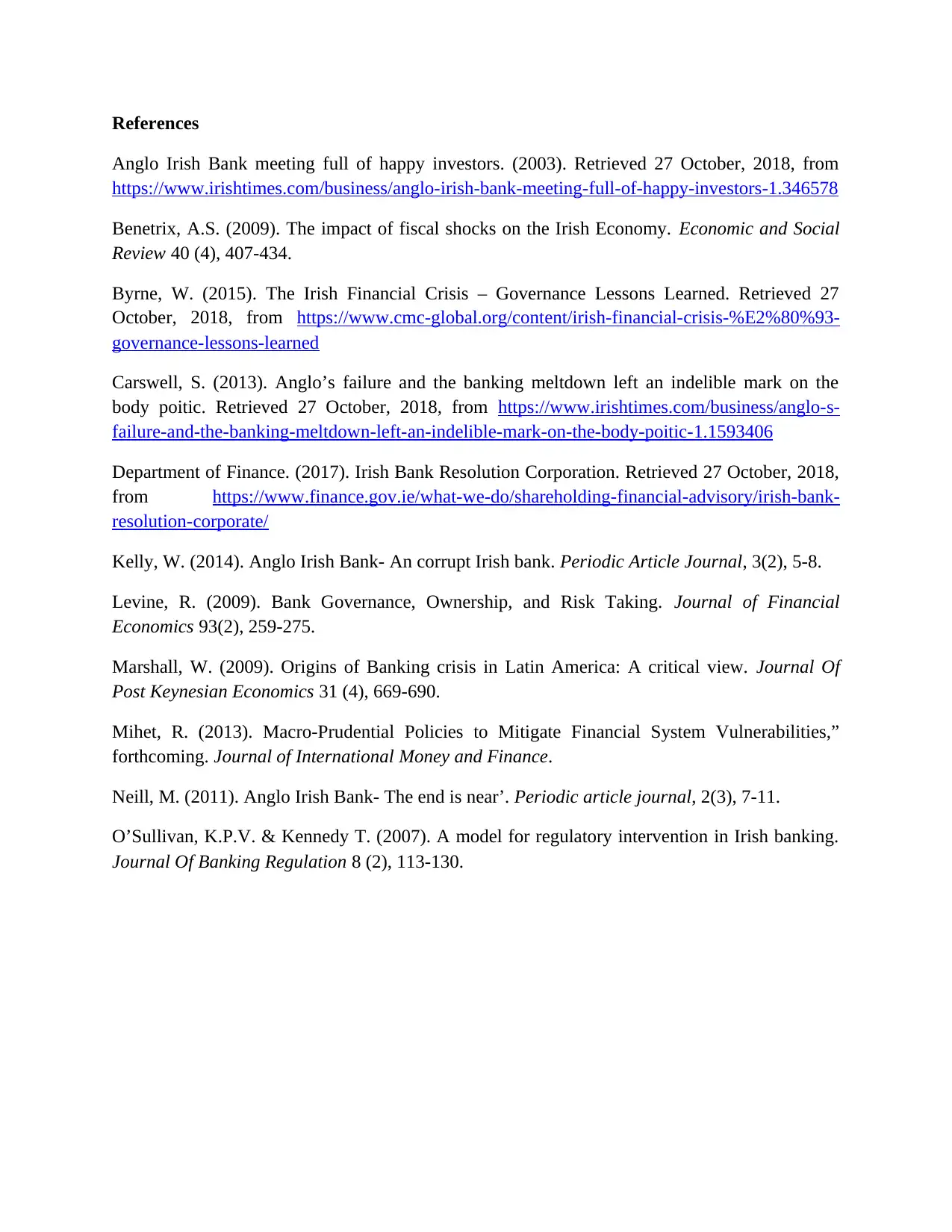
References
Anglo Irish Bank meeting full of happy investors. (2003). Retrieved 27 October, 2018, from
https://www.irishtimes.com/business/anglo-irish-bank-meeting-full-of-happy-investors-1.346578
Benetrix, A.S. (2009). The impact of fiscal shocks on the Irish Economy. Economic and Social
Review 40 (4), 407-434.
Byrne, W. (2015). The Irish Financial Crisis – Governance Lessons Learned. Retrieved 27
October, 2018, from https://www.cmc-global.org/content/irish-financial-crisis-%E2%80%93-
governance-lessons-learned
Carswell, S. (2013). Anglo’s failure and the banking meltdown left an indelible mark on the
body poitic. Retrieved 27 October, 2018, from https://www.irishtimes.com/business/anglo-s-
failure-and-the-banking-meltdown-left-an-indelible-mark-on-the-body-poitic-1.1593406
Department of Finance. (2017). Irish Bank Resolution Corporation. Retrieved 27 October, 2018,
from https://www.finance.gov.ie/what-we-do/shareholding-financial-advisory/irish-bank-
resolution-corporate/
Kelly, W. (2014). Anglo Irish Bank- An corrupt Irish bank. Periodic Article Journal, 3(2), 5-8.
Levine, R. (2009). Bank Governance, Ownership, and Risk Taking. Journal of Financial
Economics 93(2), 259-275.
Marshall, W. (2009). Origins of Banking crisis in Latin America: A critical view. Journal Of
Post Keynesian Economics 31 (4), 669-690.
Mihet, R. (2013). Macro-Prudential Policies to Mitigate Financial System Vulnerabilities,”
forthcoming. Journal of International Money and Finance.
Neill, M. (2011). Anglo Irish Bank- The end is near’. Periodic article journal, 2(3), 7-11.
O’Sullivan, K.P.V. & Kennedy T. (2007). A model for regulatory intervention in Irish banking.
Journal Of Banking Regulation 8 (2), 113-130.
Anglo Irish Bank meeting full of happy investors. (2003). Retrieved 27 October, 2018, from
https://www.irishtimes.com/business/anglo-irish-bank-meeting-full-of-happy-investors-1.346578
Benetrix, A.S. (2009). The impact of fiscal shocks on the Irish Economy. Economic and Social
Review 40 (4), 407-434.
Byrne, W. (2015). The Irish Financial Crisis – Governance Lessons Learned. Retrieved 27
October, 2018, from https://www.cmc-global.org/content/irish-financial-crisis-%E2%80%93-
governance-lessons-learned
Carswell, S. (2013). Anglo’s failure and the banking meltdown left an indelible mark on the
body poitic. Retrieved 27 October, 2018, from https://www.irishtimes.com/business/anglo-s-
failure-and-the-banking-meltdown-left-an-indelible-mark-on-the-body-poitic-1.1593406
Department of Finance. (2017). Irish Bank Resolution Corporation. Retrieved 27 October, 2018,
from https://www.finance.gov.ie/what-we-do/shareholding-financial-advisory/irish-bank-
resolution-corporate/
Kelly, W. (2014). Anglo Irish Bank- An corrupt Irish bank. Periodic Article Journal, 3(2), 5-8.
Levine, R. (2009). Bank Governance, Ownership, and Risk Taking. Journal of Financial
Economics 93(2), 259-275.
Marshall, W. (2009). Origins of Banking crisis in Latin America: A critical view. Journal Of
Post Keynesian Economics 31 (4), 669-690.
Mihet, R. (2013). Macro-Prudential Policies to Mitigate Financial System Vulnerabilities,”
forthcoming. Journal of International Money and Finance.
Neill, M. (2011). Anglo Irish Bank- The end is near’. Periodic article journal, 2(3), 7-11.
O’Sullivan, K.P.V. & Kennedy T. (2007). A model for regulatory intervention in Irish banking.
Journal Of Banking Regulation 8 (2), 113-130.
Paraphrase This Document
Need a fresh take? Get an instant paraphrase of this document with our AI Paraphraser

1 out of 8
Related Documents
Your All-in-One AI-Powered Toolkit for Academic Success.
+13062052269
info@desklib.com
Available 24*7 on WhatsApp / Email
![[object Object]](/_next/static/media/star-bottom.7253800d.svg)
Unlock your academic potential
© 2024 | Zucol Services PVT LTD | All rights reserved.





